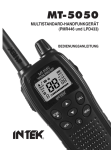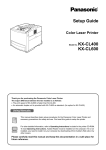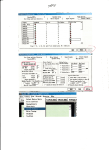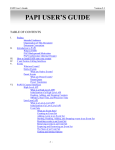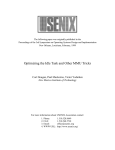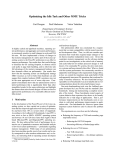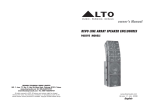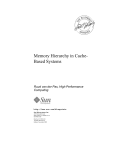Download Automatic Memory Hierarchy Characterization
Transcript
Automatic Memory Hierarchy Characterization
Clark L. Coleman and Jack W. Davidson
Department of Computer Science, University of Virginia
E-mail: {clc5q, jwd}@cs.virginia.edu
Abstract
As the gap between memory speed and processor
speed grows, program transformations to improve the
performance of the memory system have become
increasingly important. To understand and optimize
memory performance, researchers and practitioners in
performance analysis and compiler design require a
detailed understanding of the memory hierarchy of the
target computer system. Unfortunately, accurate information about the memory hierarchy is not easy to
obtain. Vendor microprocessor documentation is often
incomplete, vague, or worse, erroneous in its description of important on-chip memory parameters. Furthermore, today’s computer systems contain complex, multilevel memory systems where the processor is but one
component of the memory system. The accuracy of the
documentation on the complete memory system is also
lacking. This paper describes the implementation of a
portable program that automatically determines all of a
computer system’s important memory hierarchy parameters. Automatic determination of memory hierarchy
parameters is shown to be superior to reliance on vendor data. The robustness and portability of the
approach is demonstrated by determining and validating the memory hierarchy parameters for a number of
different computer systems, using several of the emerging performance counter application programming
interfaces.
1. Introduction
Because the gap between processor performance and
memory performance continues to grow, performance
analysis and compiler optimizations are increasingly
focused on the memory hierarchy of the target computers. To optimize memory system performance we need
to know, for any level of cache or TLB (translation
lookaside buffer), the size, line size, associativity, write
allocation and replacement policies, and whether each
cache or TLB is split or unified.
One approach to determining these parameters is to
search vendor documentation for the relevant numbers.
There are numerous deficiencies in this method, based
on the authors’ experiences:
1. Vendor documents can be incorrect. For example,
the Intel P6 Family Instruction Set Architecture Manual
[5], in its description of the CPUID instruction,
describes the 16KB L1 (Level One) data cache associativity as being 2-way when it is in fact 4-way. Later corrections to this value and several TLB values in this
manual confirm the presence of errors over time.
2. Vendor documents can be vague, such as when a
single manual attempts to describe several related processors within a family. This often leads to describing
the memory hierarchy with a range of possibilities, or
only with the common denominator parameters.
3. Vendor manuals often describe memory hierarchy
components that are used by the operating system but
are not accessible to user-level code under that operating system [7], such as the large-page TLBs in the Intel
P6 family processors [5]. Automatic characterization
reveals the memory hierarchy as actually seen by the
application programs on the system.
4. Some parameters are dependent on the system,
not the CPU, and thus are not documented fully in CPU
manuals. For example, off-chip secondary cache sizes
typically vary in powers of two among systems using a
certain CPU. The size is best determined dynamically.
5. Gathering information through searches of processor, system, and OS documents, followed by email
correspondence to resolve ambiguities and errors, is
very time-consuming in comparison to a dynamic characterization that runs in only a few minutes.
For these reasons, documentation is an insufficient
source for needed memory hierarchy information. A
superior approach would be to design a program that
can reliably perform dynamic memory hierarchy char-
acterization directly on the machines to be characterized. We have successfully designed and tested such a
program, which we describe in this paper.
1.1. Dynamic Measurement using Timing Tools
Prior tools have measured latency, bandwidth, and
cache sizes using the timing precision available in the
standard Unix/C environment [6, 1]. Through repeated
memory accesses (in which lengthy straight-line code
repeatedly dereferences and then increments a pointer)
and timings, these programs can detect the slowdown
that occurs when a data array exceeds the size of a level
of cache, and hence can determine the size of that level
of data (or unified) cache, and its latency and bandwidth. These tools are valid and useful for their
intended application.
There are limitations in this approach, however.
Existing tools do not measure instruction caches, nor
instruction or data TLBs. Thus, they do not give a complete, precise measurement of the parameters required
for optimal use of the memory hierarchy.
To address the problem of gathering accurate, reliable data about the characteristics of all aspects of the
memory hierarchy, we have designed a portable program, called AMP (for Automatic Memory Hierarchy
Parameterization), that automatically determines all key
memory hierarchy characteristics including those of the
instruction caches and TLBs. Most modern processors
incorporate hardware performance counters that can
count certain events, such as cache or TLB misses.
However, there are several challenges to using such
counters.
First, there is no common set of counters available
across all processors. The counters available and what
events are recorded vary widely even among processors
from the same vendor. Second, accessing the counters
that are available is machine and operating system
dependent. To overcome these challenges, we have
designed a middle layer module that acts as an interface
between AMP and the application program interface
(API) for accessing the counters. There are currently
several research groups providing APIs for access to
these performance counters. The APIs germane to this
project are described in Section 2.1.
A third, and perhaps most difficult challenge, is that
it is not feasible or reasonable to run measurement programs such as AMP on a standalone machine. For
example, many systems require connections to the network for file system access. Configuring a machine to
run in a standalone fashion is often not an option (e.g.,
removing a compute server from the pool of available
servers), and when it is an option, taking a machine and
rebooting it in standalone mode is time-consuming. To
address this problem, we designed AMP so it can be run
on a machine in a standard networked environment. By
carefully controlling the experiments that are run and
using statistical techniques, AMP accurately determines
the memory hierarchy parameters on a machine being
run in a standard computing environment.
The remainder of the paper has the following organization. In the next section, we address issues regarding
portability and the robustness of our measurements on
multi-tasking systems. Section 2 describes the algorithms developed to compute the various memory system parameters. Section 4 discusses the measurements
collected for a variety of systems, Sections 5 and 6
describe the implementation and availability of the software, and Sections 7 and 8 summarize the contributions
of the work and future enhancements.
2. Robustness and Portability
In this section, we address issues confronted when
running AMP on multiple targets that have different
performance counters available, with different access
methods. We also show how we solved the problems
introduced by competition on multi-tasking systems.
2.1. Performance Counter APIs and Portability
AMP currently runs primarily on top of the PCL performance counter API [2], available on several hardware platforms. A similar API effort is PerfAPI [8]. The
Rabbit API is available for x86/Linux measurements
only [4]. AMP has been ported to these APIs. Development work was undertaken in the DOS/DJGPP environment [3], which permitted direct counter access in
privileged mode under DOS, without multitasking
overhead.
We have created a middle layer module that acts as
an interface between the code implementing the algorithms described above and the performance counter
API. Queries (available in all three APIs) are used to
determine what events are available on a system (and
thus, how many levels of cache have associated
counters). Porting to a new performance counter API
only requires changes to this middle layer module.
A machine-dependent module can use machine-specific instructions to flush caches, TLBs, etc., but can be
made to just return false for all functions to minimize
porting effort. When a return value of false is seen,
the cache flushing proceeds as described in
Section 3.1., Step 1, in which code or data accesses are
used to evict from the cache the code or data of interest.
2.2. Robustness and Reliability
We observed during testing that AMP suffered a loss
of reliability whenever the APIs (or competing system
processes) caused cache misses unrelated to AMP’s
algorithms. A voting scheme eliminated this problem.
The main program actually gathers measurements in a
voting loop. An outline of the measurement and voting
approach is as follows.
1. while (vote limit not reached) do
2.
Perform experiment measuring cache
misses 8 times
3.
Take minimum of these 8 numbers
4.
Use the minimum to compute the
result (e.g. line size)
5.
Store result as the current vote
6. endwhile
7. The final value = most common vote
Using the minimum misses from multiple repetitions
discards high numbers of misses caused by context
switching or other anomalies. Our hypothesis is that no
event in the system will reduce measured cache misses,
but many events could increase them, so the minimum
is the most accurate measurement. (Note that the APIs
used count misses on a per-process basis; the problem is
not the accidental counting of misses suffered by
another process, rather the increase in AMP process
cache misses caused by cache evictions that occur during execution of another process, causing certain data
items to not be found in the cache as expected.) Thus,
computing the L1 D-cache line size involves taking
eight measurements, recording the minimum number of
misses among those eight, using that minimum to compute a line size, and making that line size the first vote,
etc. An important point here is that all measurements
are designed to produce hundreds of cache misses, or at
least dozens of TLB misses; AMP does not depend on a
precise number of misses that is small, as this would be
unreliable even after implementing this voting scheme.
In all, 64 measurements will produce 8 reliable votes.
Prior to implementing the voting scheme, AMP produced inconsistent results on different runs on very
lightly loaded Unix systems. With voting, AMP returns
the same parameters on more than 90% of all runs.
Another boost to our measurement reliability is the
computation of the performance counter API overhead.
The API might make small cache perturbations, which
need to be removed from our measurements. At startup,
AMP loops through an array that has been read into the
cache and should be small enough to remain there for a
brief duration. AMP counts the cache misses (which
would be zero, if there were no API overhead) and
takes the minimum of several counts as the overhead
for that measurement. This is done for all caches and
TLBs. The overhead is subtracted from each measurement described in this paper before any cache miss
number is used in determining any cache parameter.
3. Algorithms and Measurements
The subsections below describe our measurement
algorithms in terms of performance counters while
making reference to particular machine dependencies
only where necessary. Keep in mind when reading these
measurement algorithms that each measurement is
actually a sequence of repeated measurements, followed by a voting scheme, as discussed in Section 2.2.
In the data cache discussions, AMP uses a very large
integer array declared as a C-language static global
array within the main code module. The main module
contains all the measurement functions for the data
cache elements of the memory hierarchy. The array is
configurable in size using named constants and currently consists of 256 rows, each being 128KB in size,
for a total size of 32MB. This is substantially larger
than any currently known data cache. Hereafter, we
refer to this data structure simply as “the array.”
The strategy of AMP is to first determine the line
size (or TLB page size) for each level of the memory
hierarchy in turn. Once the line size has been determined, AMP knows how often misses will occur in further experiments that access uncached memory regions
at that level. For example, if the L1 D-cache line size is
32 bytes, then accessing a 1024 byte region of memory
that is not present in the L1 D-cache should produce
1024/32 = 32 L1 D-cache misses. The approach for
other parameters, such as total cache size and associativity, is to perform certain accesses that attempt to
thrash that cache. If thrashing occurs, AMP will get the
maximum possible miss rate for that access sequence,
which is once per cache line. Details are in the sections
below.
3.1. Data Cache Line Size
The line size of a data cache is determined using the
following algorithm.
1. Flush first few rows of the array from
the cache
2. Read current value of performance
counter for cache misses
3. Read the first row of the array
4. Read value of the performance counter
again
5. Compute the miss rate
6. Set line size to the power of two that
is nearest to the reciprocal of the
miss rate
The L1 data cache will be our initial example.
Step 1: First, the data cache must have the first few
rows of the array flushed from it. If a machine-dependent module is able to execute a cache flush instruction,
it does so. Otherwise, AMP reads the second half of the
array (i.e. the final 16MB of the array, at its current
size) several times (not just once, in case a non-LRU
replacement scheme is used.) If the first few rows of the
array were ever present in the data cache, they should
now be evicted by the later rows. This will be true as
long as 16MB exceeds the size of any level of cache.
Steps 2–5: Turn on the L1 data cache miss performance
counter, read its initial value, then read the first row of
the array. Read the performance counter again, subtract
its initial value from the new value to compute the number of L1 data cache misses that occurred. The number
of misses is divided into the number of integers in one
row of the array to give the miss rate, expressed as the
proportion of integers that caused misses.
Step 6: The final step is to determine which power of 2
is nearest to the reciprocal of the miss rate. This is the
cache line size. (AMP assumes that all cache line sizes
are a number of bytes that is a power of 2, which is true
for all data caches with which we are familiar.) The formula to compute the line size from the miss rate is:
LineSize = sizeof ( int ) × 2
1
log -----------------------MissRate
--------------------------------- + 0.5
log 2
where log refers to the natural logarithm, which is
divided by log 2 to produce the logarithm base 2 of the
reciprocal of the miss rate. This value is then rounded
by adding 0.5 and applying the floor function (truncation). Raising 2 to this power gives us the number of
integers in the cache line. A final multiplication by the
number of bytes per integer converts the units to bytes.
For other levels of cache, the appropriate performance counter is used, and the same algorithm will produce the L2 line size, Data TLB (DTLB) page size, etc.
Reliability of line size and page size computations is
discussed in Section 2.2.
One unfortunate hurdle encountered in the validation of this algorithm was the presence of hardware
errata producing invalid numbers from the L1 D-cache
read miss counter on Sun UltraSparc-I and UltraSparcII systems [9]. This counter produces more read misses
than there actually were data reads performed. We
detected these anomalous numbers, and investigation
turned up the errata sheets for the CPUs. AMP works
around this problem by using a change in the code, controlled by compilation directives for UltraSparc targets,
that uses writes instead of reads in the accesses to the
first array row. The write miss counter is verified to
work properly on these systems, and line size can be
determined as accurately as on other CPUs.
3.2. Data Cache Size
Determination of the size of a data cache uses steps
similar to determining the line size:
1. SizeHypothesis = MIN_CACHE_SIZE
2. while (SizeHypothesis is <=
MAX_CACHE_SIZE) do
3.
Read SizeHypothesis bytes at
beginning of the array
4.
Read performance counter for cache
misses
5.
Reread SizeHypothesis bytes from
beginning of array
6.
Reread performance counter
7.
if one miss per cache line then
8.
Exit the loop
9.
else
10.
Double the SizeHypothesis
11. endwhile
The algorithm iterates over cache size hypotheses
starting with a defined minimum cache size. This is a
named constant in the code that is currently 1024 bytes.
(For modern processors that have performance
counters, no cache will be this small, and the processors
of several CPU generations ago that had cache sizes as
small as 1KB did not have performance counters and
will not be subject to our measurements.)
Steps 3–6: The first 1KB of the array is read to place it
into the cache (if it will fit.) The appropriate performance counter is started, the hypothesized cache size is
read a second time, and the new value of the counter is
read. A miss rate for this second pass through the
hypothesized cache size is computed from the difference in the counter values read.
AMP defines the expected failure miss rate as the
miss rate that it will see if the hypothesized cache size
exceeds the actual cache size and the first read pass
wrapped around the cache and evicted itself, causing
the second read pass to miss once for each cache line.
Thus, the expected failure miss rate is the reciprocal of
the already-computed cache line size.
Steps 7–10: If the miss rate does not exceed a threshold
fraction of the expected failure miss rate (a named constant, currently 0.80, empirically derived from experiments on several systems), then AMP concludes that
the test data fit into the cache. In this case, the hypothesized size is doubled, and AMP iterates again.
When AMP finds a miss rate that indicates failure, it
could assume that the previous hypothesis (the largest
size that did not fail) is the cache size. However, not all
cache sizes are powers of two; for example, the Alpha
21164 CPU has an on-chip unified secondary cache that
is 96KB in size [10]. To accurately measure the size of
such a cache, AMP iterates between the last non-failure
test size and the first failed test size, in increments of
25% of the difference between them.
3.3. Data Cache Associativity
Given the cache size, the associativity can be found
by experiments that try to thrash the cache.
1. AssocHypothesis = 1
2. while (AssocHypothesis < NbrOfCacheLines) do
3.
Access the array (2 * AssocHypothesis) times at spacings CacheSize /
AssocHypothesis) bytes apart
4.
Read value of performance counter
for cache misses
5.
Re-access the array (2 * AssocHypothesis) times at spacings
(CacheSize / AssocHypothesis) bytes
apart
6.
Re-read performance counter
7.
Compute miss rate
8.
if miss rate less than thrashing
threshold then
9.
Increase AssocHypothesis to next
feasible value
10. endwhile
11. if Thrashed then
12. return AssocHypothesis
13. else
14. return NbrOfCacheLines (i.e.
fully associative)
Step 1: Start with direct-mapped as our hypothesis.
Step 2: The limit is a fully associative cache.
Steps 3-10: Choose an access pattern that would thrash
if the true associativity matched our hypothesis. For
example, if a primary data cache is known to be 16KB
in size, then repeatedly and alternately accessing two
array elements that are 16KB apart would create a miss
rate close to 100% if the cache is direct-mapped (1-way
associative), as the elements would map to the same
cache line and evict each other from the cache. In this
case, the function would terminate and return 1 as the
associativity.
Steps 11-12: If thrashing is not observed, the hypothesis is advanced to the next integer that is a factor of the
number of lines in the cache. For example, with a 16KB
cache with 32 byte lines, there are 512 lines in the
cache. The associativity should be a factor of 512. In
this example, the factors are all powers of two, so the
next associativity hypothesis is double the previous
hypothesis, but this cannot be assumed. AMP will work
correctly on machines with 3-way, 5-way, etc. caches.
In general, for an associativity hypothesis of k, AMP
repeatedly and sequentially accesses 2k array elements
spaced N/k bytes apart, where N is the array size. For
the 2-way associative hypothesis in the 16KB array,
AMP accesses 4 elements at relative addresses within
the array of 0, 8KB, 16KB, and 24KB. This will thrash
a 2-way (but not a 4-way) associative cache. Testing
proceeds until AMP sees cache thrashing.
3.4. Write Allocation Policy
AMP can determine whether a cache allocates a
cache line upon a write miss. After flushing the cache,
AMP writes to a region of the array that is smaller than
the size of the cache being tested. Subsequent reads to
the same region will be hits if the write misses caused
cache line allocations, and will miss at the rate of once
per line if the cache employs a no-write-allocate policy.
Because AMP assumes that each downstream (larger)
cache includes the entire contents of each upstream
(smaller) cache, once AMP reaches a level in the cache
hierarchy with a write-allocate policy, all downstream
caches are assumed to be write-allocate caches, also.
3.5. Replacement Policy
The three common approaches to determining which
set to replace after a cache miss are true LRU, pseudoLRU, and random. The two LRU schemes will be similar for all repeatable access sequences: a certain set will
always be chosen for replacement for a given sequence
of hits and misses. Depending on the pseudo-LRU
implementation and the access sequence, true LRU and
pseudo-LRU might choose different sets. Random
replacement will choose a set to replace based upon
some random value supplied by the system, and will not
demonstrate repeatable behavior for all repetitions of an
access sequence. AMP is thus able to distinguish
between LRU and random. Ongoing work will differentiate pseudo and true LRU.
For 4-way and 8-way associative caches and TLBs,
AMP accesses N array elements that map to the same
set, where N is the associativity. Then it accesses the
first N-1 elements again, followed by an (N+1)st element that maps to the same set. This last element will
cause eviction of one of the first N elements. Turning
on the appropriate cache miss counter and accessing
element i will determine if element i was replaced.
Repeating the entire experiment and iterating i from 0
to N-1 will give AMP a statistical picture of the
replacement policy. If only a single set among the first
N sets is ever replaced when the (N+1)st element is
accessed, then some form of LRU replacement is being
used. If the misses are scattered throughout all N sets,
the replacement was random.
3.6. Data Cache: Split or Unified
It is essential to know whether a given level of cache
is data-only or unified when analyzing performance or
performing certain compiler optimizations. AMP can
detect a unified cache by simply reading a portion of
the array that equals the cache size, then executing a
synthesized chunk of object code that is at least that
size (but which does not perform data operations), and
then re-read the portion of the array. If the second pass
through the data array misses once per cache line, then
the code execution must have evicted the data from the
cache in question, and AMP concludes that it is unified.
An important result from the determination of unified or split status is that AMP can obtain some useful
information in the absence of a complete set of performance counters. If a CPU has an L2 data cache miss
counter, but not an L2 instruction cache miss counter,
AMP can characterize the line size, total size, associativity, and write policies of the L2 cache using the data
counters only. After AMP determines that the cache is
unified, the absence of an L2 instruction miss counter is
not a problem. The same applies to unified TLBs.
3.7. Instruction Cache Line Size
Instruction cache line size is computed in the same
way as the data counterpart, except that AMP executes
a large block of straight-line code instead of accessing a
region of a data array. The code block is generated from
macros that repeatedly perform additions and subtractions on a pair of variables, leaving them with their initial values so that no overflow will occur when the
macro is repeated thousands of times. The function containing the large block of code is compiled without optimization to ensure that the code does not disappear
during compilation. The gcc compiler is used in order
to take advantage of a non-standard extension to the C
language that it provides, viz. the ability to take the
object code address of a label in the code using the
“&&” operator. This operator is used to compute the size
of a block of code, which is then used (along with the
cache miss counter values) to compute the miss rate.
AMP then computes the line or page size directly from
the miss rate using the equation from Section 3.1.,
dropping the sizeof(int) multiplication.
3.8. Instruction Cache Size
AMP computes the I-cache sizes using a function
that contains a sequence of switch statements with 32
cases each, each case containing a code macro that
generates 1KB of object code for the target machine.
This macro is obtained from a header file that is generated automatically. A preliminary step in the software
building process for AMP uses the gcc ‘&&’ operator
to compute object code sizes for the code macro, along
with other pieces of code such as the surrounding control flow and a NOP instruction on the target machine.
Using these sizes, the preliminary program generates a
header file with macros that will expand to 1KB and
4KB of object code on the target machine, within a few
bytes.
The function executes specified (via input parameters) cases within the switch statement to prime
the instruction caches and TLB, then turns on the
requested performance counter and executes the same
cases again. As with the data case, AMP detects the
expected failure miss rate when it has exceeded the size
of the cache, then performs a finer-grained search
between the final pair of powers of two to get the final
size.
As secondary and tertiary (L3) caches can be quite
large, a clone of this function is provided in which each
case of the switch statement has 4KB of object
code from a macro instead of only 1KB. This function
is called automatically as the size being tested exceeds
the size that can be tested using 1KB macros.
In order to keep the size of these large blocks of synthetic code within very precise bounds, AMP measures,
sided, reducing the miss rate to nearly zero. After much
repetition and validation of these results, vendor
employees confirmed that the IRIX OS can be configured to detect TLB thrashing and dynamically resize
the pages to use more than 16KB per page. Thus, the
repetitions of measurements, designed to increase
robustness, gave IRIX time to detect repeated thrashing
and eliminate it. AMP was redesigned to detect and
report this dynamic resizing of pages, which has only
been seen on IRIX systems to date.
Much to our surprise, AMP stopped reporting
dynamic page resizing on a certain date. Our system
administrators confirmed that a new release of IRIX
had been installed, and they had not bothered to enable
the page resizing. This confirmed the accuracy of
AMP’s page resizing detection algorithm.
using the gcc && operator, the code size produced by
if and switch statements that surround the code
macros. Every few cases within each switch statement, AMP uses a different macro that produces
slightly less code in order to compensate for the overhead of this control code. Because gcc cannot compile
a switch statement with 1024 cases, each of which
has 1KB of code, AMP uses a sequence of 32 switch
statements, each of which has only 32 cases, to
achieve the code size needed. Even so, gcc can easily
exhaust virtual memory limits on many systems. We
also discovered an error in gcc code generation for
such a large function on Compaq Alpha systems, which
has been fixed by the gcc maintainers.
3.9. Instruction Cache Associativity
AMP computes associativity using the same function with the large switch statements, executing noncontiguous blocks of code located at relative spacings,
just as it accessed array elements at certain relative
spacings in Section 3.3.
4. Summary of Measurements
Table 1 summarizes the measurements collected for
some popular machines. Associativity is measured in
number of degrees; all other parameters are measured in
bytes. N/C indicates that No Counter is available to
count misses for that memory hierarchy element.
The systems used, respectively, are a 133MHz Pentium, 200MHz Pentium Pro, 233 MHz Pentium II, 167
MHz UltraSparc-I, and an SGI Octane with 225 MHz
R10000 CPU. The Pentium CPUs have entirely different performance counter hardware (and software interfaces) than the Pentium-II/Pentium Pro family CPUs.
For TLB parameters, size is in number of entries. All
machines had unified L2 caches; the R10000 has a unified TLB. All L1 caches were split. The P5 and UltraSparc L1 D-caches were no-write-allocate. No random
replacement schemes were detected. Results were validated using the time consuming sources mentioned previously: vendor documentation, vendor personnel, etc.
3.10. TLB Measurements
All algorithms have been successfully tested and
confirmed to produce valid results for instruction and
data TLBs, where the analogous parameters are page
size (instead of line size), TLB entries (instead of size
in bytes), and associativity.
An interesting anomaly was detected on our MIPS
R10000 CPU in an SGI Octane system running the
IRIX operating system. Initial efforts to determine the
number of TLB entries failed. Inspection of the raw
data coming from the TLB miss counters showed that,
as our SizeHypothesis neared the size reported in vendor documents (2 MB, in 64 entries that each map pairs
of 16 KB sub-pages), thrashing occurred but then subL1 Code
L1 Data
L2
ITLB
DTLB
Line/Size/Ass.
Line/Size/Ass.
Line/Size/Ass.
Page/Size/Ass.
Page/Size/Ass.
P5-133
32 / 8K / 2
32 / 8K / 2
N/C
4K / 32 / 2
4K / 64 / 4
PPro-200
32 / 8K / 2
32 / 8K / 2
32 / 256K / 4
4K / 32 / 4
N/C
PII-233
32 / 16K / 4
32 / 16K / 4
32 / 512K / 4
4K / 32 / 4
N/C
USparc-I
32 / 16K/ 2
32 / 16K / 1
64 / 512K / 1
N/C
N/C
R10K-225
64 / 32K / 2
32 / 32K / 2
128 / 1024K / 2
32K / 64 / 64
32K / 64 / 64
System
TABLE 1. Measured Cache and TLB Parameters
5. Implementation
AMP is implemented in 12 modules of ANSI standard C comprising 29,214 lines of code including comments. It is compiled using gcc version 2.95.2. Run
times range from 5 to 50 minutes on different systems
(absence of certain counters speeds up the run times
considerably; TLB measurements are the most time
consuming.) The executable file is approximately 9MB.
Using a preprocessor symbol, this can be reduced to
800KB to create a DOS bootable diskette with a
reduced version of AMP for Intel x86 PCs. The primary
code reduction in this version is the removal of the
majority of the synthetic code modules discussed in
Section 3.8.. This prevents AMP from determining the
size of any L2 instruction cache that exceeds 256KB.
As x86 PCs have a unified L2 cache, the L2 parameters
will have already been determined using data cache
measurements, and AMP will be able to determine that
the L2 cache is unified if it does not exceed 512KB.
The diskette version of AMP can be used to test multiple PCs quickly without installation of any APIs.
6. Software Availability
The file ftp://ftp.cs.virginia.edu/
pub/AMP/README contains instructions for downloading executables for various target machines. Source
code will be available here soon.
7. Ongoing Work
Enhancements nearing completion include miss penalty characterization for caches and TLBs, detection of
sub-block and sub-page schemes, and measurement of
hardware elements such as branch target buffers. New
target systems will be used as they become available,
and measurements will be maintained at the FTP site.
8. Summary
Knowing the memory hierarchy parameters of a
computer system is vital information for tuning memory performance models and applying optimizations
geared to improving memory performance. Unfortunately, obtaining the memory hierarchy parameters of
any particular system’s memory hierarchy has been difficult. Vendor literature is sometimes erroneous, often
hard to find for a particular system, and usually vague.
Furthermore, some systems have memory system characteristics that can be set by the operating system. To
address these problems, we have developed AMP. AMP
accurately determines the memory hierarchy parameters of a computer system by running a set of experiments and using statistical techniques to compensate
for any outside interference. Using AMP, a user can
determine line size, associativity, capacity, write allocation and miss replacement policies, and organization of
the caches and TLBs of the memory hierarchy. Our
approach has been verified by running AMP on a variety of architectures and systems. Interestingly, AMP
uncovered several important errors and omissions in
vendor documents. Many interesting obstacles were
overcome, including dynamic TLB page resizing, hardware errata on the counters, process competition on the
target systems, and varying overheads of multiple APIs.
9. References
[1] Brown, A., and M. Seltzer, “Operating System Benchmarking in the Wake of Lmbench: A Case Study of the Performance of NetBSD on the Intel x86 Architecture,”
Proceedings of the1997 ACM SIGMETRICS Conference,
Seattle, WA, June, 1997, pp. 214–224.
[2] Berrendorf, Rudolf, and Heinz Ziegler, PCL: The Performance Counter Library, web site http://www.fzjuelich.de/zam/PCL/.
[3] Delorie, D.J., developer of DJGPP, web site http://
www.delorie.com/DJGPP/.
[4] Heller,
Don,
web
site
http://
www.scl.ameslab.gov/Projects/Rabbit/.
[5] Intel Corporation, Intel Architecture Software Developer’s Manual, volume 2: Instruction Set Reference, 1997.
Note page 3-74 for CPUID instruction.
[6] McVoy, L., and C. Staelin, “lmbench: Portable Tools for
Performance Analysis,” Proceedings of the 1996 Usenix
Technical Conference, San Diego, CA, January, pp. 279–295.
[7] MIPS Technologies, MIPS R10000 Microprocessor
User’s Manual, version 2.0, October 10, 1996. Compare section 14.6 and section 16.3 re: wired TLB entries.
[8] Mucci, Philip J., Shirley Browne, Christine Deane, and
George Ho, “PAPI: A Portable Interface to Hardware Performance Counters”, Department of Defense High Performance
Computing Modernization Program Users Group Conference,
Monterey, CA, June 7-10, 1999. See http://
icl.cs.utk.edu/projects/papi/.
[9] Sun Microsystems, UltraSparc-IIi User’s Manual,
1997.
[10] Compaq Computer Corporation, Alpha Architecture
Handbook, Version 4, 1998.








